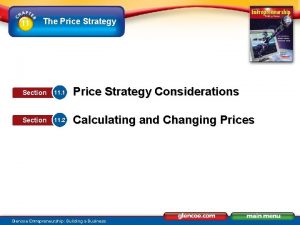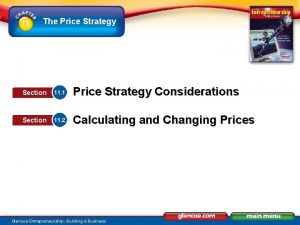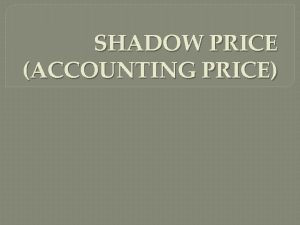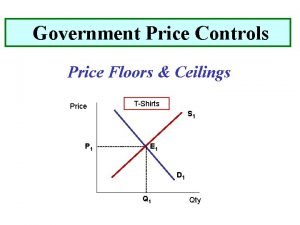11 The Price Strategy Section 11 1 Price













- Slides: 13

11 The Price Strategy Section 11. 1 Price Strategy Considerations Section 11. 2 Calculating and Changing Prices Glencoe Entrepreneurship: Building a Business

SECTION 11. 1 Price Strategy Considerations Section Objectives • • • Identify factors that affect price strategy. Summarize the marketing objectives related to pricing. Describe the components that go into making price strategy decisions. Chapter 11 The Price Strategy Glencoe Entrepreneurship: Building a Business

SECTION 11. 1 Price Strategy Considerations Content Vocabulary Basic pricing price skimming penetration pricing Product life cycle Chapter 11 The Price Strategy Glencoe Entrepreneurship: Building a Business

Pricing Strategy Decisions Consider your target market as you make these pricing strategy decisions: Select a basic approach to pricing. Determine your pricing policy. Set a price based on the stage of the product life cycle. 4

Setting a Basic Price There are three basic approaches to pricing: cost-based pricing demand-based pricing competition-based pricing 5

Setting a Basic Price Cost-based pricing – Figure your cost to make or buy your product. Determine the related cost of doing business. Then add your projected profit margin to add up to the price! Demand – Based Pricing – Determine what your customers are willing to pay for your product. Only works when the demand is inelastic and when customers see your product as different from the competition. i. e. i. Phone! Competition – Based Pricing – Only focused on being competitive. Determine what your competitors charge. Then decide to price below, in line with or above the competition. NOTE: A business can use a combination of all of the above to price their items. 6

SECTION 11. 1 Price Strategy Considerations Pricing Policies Establishing a pricing policy frees you from making the same pricing decisions over and over again and lets employees and customers know what to expect. Chapter 11 The Price Strategy Glencoe Entrepreneurship: Building a Business

SECTION 11. 1 Price Strategy Considerations Pricing Policies A flexible-price policy is one in which customers pay different prices for the same type or amount of merchandise. i. e. car dealerships A one-price policy is one in which all customers are charged the same price for all the goods and services offered for sale. Strongly recommended for service businesses. i. e. most retail stores! Chapter 11 The Price Strategy Glencoe Entrepreneurship: Building a Business

Product Life Cycle Pricing All products move through the four-stage life cycle: 1 Introduction 2 Growth 3 Maturity 4 Decline 9

Product Life Cycle Pricing Introduction – Sales volume is relatively low, marketing costs are high, profits are low or even negative. Use price skimming or penetration pricing. May discourage competition. Growth – Sales climb rapidly, unit costs are decreasing, product begins to show a profit, competitors come into the market. Make very slight changes to prices to attract new customers. Maturity –Sales begin to slow and profit peak. Profits fall as competition increases. Identify new markets or make improvements. Goal is to stretch the life cycle. Automobiles have been in the maturity stage for 30 years. Decline – Sales & Profits continue to fall. Cut prices to generate sales or clear inventory. Products (or businesses) are phased out. 10

SECTION 11. 1 Price Strategy Considerations Product Life Cycle Pricing Price skimming is commonly used when introducing a product. Chapter 11 The Price Strategy Glencoe Entrepreneurship: Building a Business price skimming the practice of charging a high price on a new product or service in order to recover costs and maximize profits as quickly as possible; the price is then dropped when the product or service is no longer unique

SECTION 11. 1 Price Strategy Considerations Product Life Cycle Pricing Penetration pricing is also commonly used when introducing a product. Chapter 11 The Price Strategy Glencoe Entrepreneurship: Building a Business penetration pricing a method used to build sales by charging a low initial price to keep unit costs to customers as low as possible

SECTION 11. 1 Price Strategy Considerations Product Life Cycles – With the introduction of Blue-ray disc players and other High-Definition formats, DVD players moved closer to the end of the maturity stage of their life cycle. What are some products that are still in their growth phase? Chapter 11 The Price Strategy Glencoe Entrepreneurship: Building a Business
 Ano ang ibig sabihin ng price floor?
Ano ang ibig sabihin ng price floor? Hát kết hợp bộ gõ cơ thể
Hát kết hợp bộ gõ cơ thể Lp html
Lp html Bổ thể
Bổ thể Tỉ lệ cơ thể trẻ em
Tỉ lệ cơ thể trẻ em Chó sói
Chó sói Tư thế worms-breton
Tư thế worms-breton Hát lên người ơi alleluia
Hát lên người ơi alleluia Môn thể thao bắt đầu bằng chữ đua
Môn thể thao bắt đầu bằng chữ đua Thế nào là hệ số cao nhất
Thế nào là hệ số cao nhất Các châu lục và đại dương trên thế giới
Các châu lục và đại dương trên thế giới Cong thức tính động năng
Cong thức tính động năng Trời xanh đây là của chúng ta thể thơ
Trời xanh đây là của chúng ta thể thơ Cách giải mật thư tọa độ
Cách giải mật thư tọa độ

























